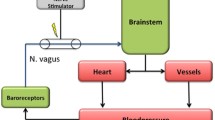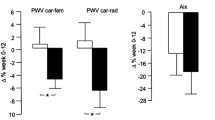Abstract
Systolic blood pressure (SBP) is frequently measured in rats by the tail cuff method, which usually comprises pulse/flow disappearance and reappearance during cuff inflation (Inf) and deflation (Def), separated by an interval between cycles (IBC). Although Def values are habitually used to estimate SBP, in 58 Wistar rats we found (Def–Inf) to be −6 ± 1 mmHg, indicating that Def < Inf in most cases. When the IBC was lengthened to 2 min, (Def–Inf) was increased to −17 ± 2 mmHg, indicating the probable accumulation of a vasodilating metabolite. This increase of (Def–Inf) was prevented by papaverine, indicating its relation to smooth muscle contractility. Adrenergic blockade did not prevent the increase of (Def–Inf), but pretreatment with L-NAME decreased it to −5 ± 2 mmHg (p < 0.05). Simultaneous measurement of SBP by tail-cuff method and carotid cannulation revealed that the Inf value was the most accurate estimation of intravascular SBP. We conclude that: (1) the Inf value should be taken as representative of SBP, since depending on the duration of suprasystolic compression the Def value can underestimate it, and (2) nitric oxide accumulation due to flow deprivation was the main cause of SBP underestimation by Def values.
Similar content being viewed by others
References
Van Vliet V.N., Chafe L.L., Antic V., Schnyder-Candrian S., Montani J.-P., Direct and indirect methods used to study arterial blood pressure. J. Pharmacol. Toxicol. Methods 44: 361–373, 2000.
Byrom F.B., Wilson C., A plethysmographic method for measuring systolic blood pressure in the intact rat. J. Physiol. 93: 301–304, 1938.
Dodson L.F., Mackaness G.B., The estimation of basal blood pressure in rat by tail oscilloscope. Br. J. Exp. Pathol. 38(6): 618–627, 1957.
Lucas J., A modified indirect method of blood pressure measurement in the conscious and anaesthetized rat. J. Physiol. 218(1): 1P–3P, 1971.
Martinelli J.G., Beraldo P.S., Campos G.P., da Costa e Silva A., A new plethysmograph for detecting arterial pulse waves in rat tail. Nephron 39(1): 61–63, 1985.
Sobin S.S., Accuracy of indirect determinations of blood pressure in the rat; relation to temperature of plethysmograph and width of cuff. Am. J. Physiol. 146: 179–186, 1946.
Maistrello I., Matscher R., Measurement of systolic blood pressure of rats comparison of intraarterial and cuff values. J. Appl. Physiol. 26: 188–193, 1969.
Buñag R.D., Riley E., Simultaneous measurements in awake rats of drug-induced changes in carotid and tail-cuff systolic pressures. J. Appl. Physiol. 36(5): 621–624, 1974.
Newman D.L., Looker T., Simultaneous measurement of the systolic blood pressure and heart rate in the rat by a transcutaneous method. Lab. Anim. 6(2): 207–211, 1972.
Reichle F.A., Noninvasive blood pressure measurement in the rat by ultrasonic auscultation. J. Surg. Res. 11: 539–544, 1971.
Rowberg A., Franklin D., Van Citters R.L., Nontraumatic method for measurement of blood pressure in animals with tails. J. Appl. Physiol. 27: 301–302, 1969.
Hermansen K., A new method for determination of the systolic blood pressure in conscious rats. Life Sci. 9: 1233–1237, 1970.
Ikeda K., Nara Y., Yamori Y., Systolic and mean blood pressure determination by a new tail cuff method in spontaneously hypertensive rats. Lab. Anim. 25(1): 26–29, 1991.
Lee R.P., Wang D., Lin N.T., Chou Y.W., Chen H.I., Modified technique for tail cuff pressure measurement in unrestrained conscious rats. J. Biomed. Sci. 9(5): 424–427, 2002.
Palbøl J., Henningsen J., Blood pressure measurements in the conscious rat. An improved photoelectric, sphygmomanometric device. Scand. J. Urol. Nephrol. 13(3): 319–321, 1979.
Wen S.F., Tremblay J.M., Qu M.H., Webster J.G., Impedance method for blood pressure measurement in awake rats without preheating. Hypertension 11(4): 371–375, 1988.
Buñag R.D., Pressor effects of the tail-cuff method in awake normotensive and hypertensive rats. J. Lab. Clin. Med. 78(4): 675–682, 1971.
Fregly M.J., Factors affecting indirect determination of systolic blood pressure of rats. J. Lab. Clin. Med. 62: 223–230, 1963.
Friedman M., Freed S.C., Microphonic manometer for indirect determination of systolic blood pressure in the rat. Proc. Soc. Exp. Biol. Med. 70: 670–672, 1949.
Resurreccion A.V., Caster W.O., Problems in the interpretation of blood pressure changes seen in rats fed a breakfast cereal. Life Sci. 22:1821–1826, 1978.
Pfeffer J.M., Pfeffer M.A., Frohlich E.D., Validity of an indirect tail-cuff method for determining systolic arterial pressure in unanesthetized normotensive and spontaneously hypertensive rats. J. Lab. Clin. Med. 78(6): 957–962, 1971.
Irvine R.J., White J., Chan R., The influence of restraint on blood pressure in the rat. J. Pharmacol. Toxicol. Methods 38(3): 157–162, 1997.
Kusaka M., Kishi K., Sokabe H., Does so-called streptozocin hypertension exist in rats? Hypertension 10(5): 517–521, 1987.
Bazil M.K., Krulan C., Webb R.L., Monitoring of cardiovascular parameters in conscious spontaneously hypertensive rats. J. Cardiovasc. Pharmacol. 22(6):897–905, 1993.
Buñag R.D., Mueting N., Riley E., Regional vascular influences on tail-cuff measurements of drug-induced changes in systolic pressure. J. Appl. Physiol. 39:724–727, 1975.
Yamakoshi K.I., Shimazu H., Togawa T., Indirect measurement of instantaneous arterial blood pressure in the rat. Am. J. Physiol. 237(5): H632–H637, 1979.
Swales J.D., Tange J.D., A photoelectric method of blood pressure measurement in the rat. J. Lab. Clin. Med. 75: 879–885, 1970.
Dowd D.A., Jones D.R., A method for recording baby rat systolic blood pressures. J. Appl. Physiol. 25: 772–774, 1968.
Buñag R.D., Validation in awake rats of a tail-cuff method for measuring systolic pressure. J. Appl. Physiol. 34: 279–282, 1973.
Needleman P., Johnson M. Jr., Vasodilators and the treatment of angina. In: Goodman Gilman A., Goodmsn L.S., Gilman A. (Eds), Goodman and Gilman´s The Pharmacological Basis of Therapeutics. 6th edn., Macmillan Publishing Inc., Co, New York, 1980, pp. 830.
Moncada S., Higgs E.A., The discovery of nitric oxide and its role in vascular biology. Br. J. Pharmacol. 147: S193–S201, 2006.
Münzel T., Afanas’ev I.B., Kleschyov A.L., Harrison D.G., Detection of Superoxide in Vascular Tissue. tissues. Arterioscler. Thromb. Vasc. Biol. 22:1761–1768, 2002.
Kojda G., Harrison D., Interactions between NO and reactive oxygen species: patophysiological importance in atherosclerosis, hypertension, diabetes and heart failure. Cardiovasc. Res. 43:562–571, 1999.
Villa L.M., Salas E., Darley-Usmar V.M., Radomski M.W., Moncada S., Peroxynitrite induces both vasodilation and impaired vascular relaxation in the isolated perfused rat heart. Proc. Natl. Acad. Sci. USA, 91:12383–12387, 1994.
Liu S., Beckman J.S., Ku D.D., Peroxynitrite, a product of superoxide and nitric oxide, produces coronary vasorelaxation in dogs. J. Pharmacol. Exp. Ther. 268:1114–1121, 1994.
Author information
Authors and Affiliations
Corresponding author
Additional information
Mariana Fritz—Recipient of a Fellowship from the Agencia Nacional de Promoción Científica y Tecnológica (ANPCYT), República Argentina.
Gustavo Rinaldi—Established Investigator of the Consejo Nacional de Investigaciones Científicas y Técnicas (CONICET), República Argentina.
Rights and permissions
About this article
Cite this article
Fritz, M., Rinaldi, G. Influence of nitric oxide-mediated vasodilation on the blood pressure measured with the tail-cuff method in the rat. J Biomed Sci 14, 757–765 (2007). https://doi.org/10.1007/s11373-007-9191-1
Received:
Accepted:
Published:
Issue Date:
DOI: https://doi.org/10.1007/s11373-007-9191-1




